
Single dad finds affordable option for son’s preschool needs

By Jennifer Quinonez for Los Angeles Universal Preschool

“I’m a single dad raising two kids, and everything is so expensive these days,” said Hawthorne resident Theo Mays, Sr.
Mays is a mail carrier and says he earns too much money to qualify for programs that would help pay for his children’s educational needs. Yet, he sacrifices every month to pay for the basic necessities such as the mortgage, health insurance and more. He says there was no question that finding a preschool for his youngest child was top priority.
“Financially, I needed help and Ms. Toi’s preschool program was the answer,” said Mays. “Not only did she provide an affordable program, she’s also giving my son a jump start.
“The core of his learning starts here, and even though I do take a very active role, I work full time. It’s reassuring to me that I know he’s getting the basics taken to another level.”
‘Ms. Toi’ is Toimicia Deffebaugh, a Family Child Care provider in South Los Angeles who operates a preschool out of her home. Mays says Deffebaugh’s educational and nurturing environment coupled with the affordability factor made it an easy decision for him to have his son attend her program.
 “The parents in my community want preschool, but it’s not affordable, and there’s little high- quality access,” says Deffebaugh. “So, a lot of four-year-olds are sitting at home, with elderly grandparents or other family members. I have a lot of grandmas calling me realizing their grandkids need to be better socialized, but not sure what to do.”
“The parents in my community want preschool, but it’s not affordable, and there’s little high- quality access,” says Deffebaugh. “So, a lot of four-year-olds are sitting at home, with elderly grandparents or other family members. I have a lot of grandmas calling me realizing their grandkids need to be better socialized, but not sure what to do.”
Since 2005, Los Angeles Universal Preschool (LAUP) has funded hundreds of preschools like Deffebaugh’s throughout Los Angeles County, giving people like Theo Mays the chance to have his child experience a high-quality preschool at little or no cost.
“All four-year-olds deserve the chance to thrive and live up to their fullest potential,” said LAUP Chief Executive Officer Celia C. Ayala. “That’s why it’s our goal to keep funding quality preschool education in the county, to make it more accessible and affordable to thousands of families.
“We need children to participate in a positive learning environment while getting ready for kindergarten, regardless of their parents’ financial situation, because their future success in life depends on it.”
 Deffebaugh notes that preschool gives families a great introduction to preparing their child and themselves for lifelong success.
Deffebaugh notes that preschool gives families a great introduction to preparing their child and themselves for lifelong success.
“In preschool, a child’s vocabulary expands weekly and children learn through play,” said Deffebaugh. “Children learn to count and their letters and numbers through songs, and movement, and creative expression and that’s why playing is so very important to learning.
“If it’s fun, they’ll grasp it.”
For Mays, preparing his son for kindergarten is top priority and finding a program that offers support and quality has made all the difference in the world.
“As a parent, you don’t’ know everything, but here, through this preschool teacher and LAUP, I’ve learned about things like nutrition, and why playing is important to my son’s learning, and how to help him at home,” said Mays. “I understand now that a child’s learning starts at a very young age. I didn’t have this opportunity with my now 12-year-old and I wish I had.”
For information about LAUP preschools throughout Los Angeles County, call 866-675-5400 or visit www.laup.net.
More stories from our ‘Preschool Cool’ series:
LAUP offers education resources to aspiring teachers
How to help the transition from preschool to Kindergarten
The economic impact of preschool
Good habits begin in preschool
REVIEW: Crooked Road
Review by LaMonica Peters
Finding The Lost Studio on La Brea Avenue was like being on a treasure hunt. This quaint theater house isn’t easily noticeable from the street, but once I was inside the intimate space I knew I was in for something special.
Crooked Road, written by Erin Gaw, is a story about Anne Morris (played by Kristal Adams) and her journey to get her life and love back after spending eight years caring for her family.
The play opens with video vignettes uniquely displayed on the back wall of the set. Black and white images of a love found and lost between Anne and Erik Miller (played by Erik Snodgrass) sets up what’s to come. As fate would have it, Anne reunites with her college sweetheart Erik as the family decides to rent their home to save money. The family owns a boutique real estate firm and the failing economy forces them to downsize. Erik is now the lead singer of a successful local band and he unknowingly agrees to rent out the family’s home while back in town to perform.
Getting back to love is no easy task for Anne or Erik. While Anne’s overbearing father Walter Morris (played by Kabin Thomas) is trying to arrange marriage for her with a man she doesn’t love, Erik is pursued by fellow band mate Jane Harwell (played by Corissa Pacillas Smith). After some soul searching, Anne faces her fears of putting herself first and being in love again by letting Erik know that she still loves him. Ultimately they both discover that true love never dies.
I’d be remiss if I didn’t mention that this cast was multi-racial and the couple who played the main characters was interracial. What was beautiful about watching this story unfold was that race was never an issue in the story line. It simply dealt with issues of family, friendship and love that all people experience in life. Maybe I’m an idealist, but I felt like I had a glimpse into the future where racial identity is a thing of the past and I loved what I saw.
Music is an important aspect of the plot and there was plenty of live music throughout the show with original pieces written by Ted and Thena Beam. Though the vocal performances weren’t strong, it was nice to see actors stretch their abilities. 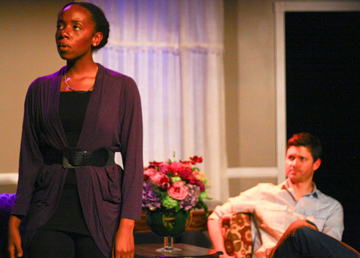
Kristal Adams and Erik Snodgrass are solid as the leads but I was most impressed by Sarah Morales (played by Anna Klein). From the moment she appeared on stage, it was like a new energy had been injected; she is a natural. In one defining scene, Sarah confides in Anne about the decisions she made in her past relationship, using the Shel Silverstein book The Giving Tree as an analogy. I felt authentic emotion between the two characters and I believe Anna Klein’s presence had a lot to do with it. Anne’s sister Mary Davis (played by Kelicea Meadows), reminded me of a younger Taraji P. Henson. She had great comedic timing and delivery, providing laughs whenever she appeared.
Crooked Road is a modern day, coming-of-age story that reminds you of how short life can be and how one decision can change everything. But it also reminds you that there are second chances in life if you have the courage to take advantage of them.
Crooked Road directed by Naisa Wong
Performances through Sunday, March 27, 2011
For more information, go to www.streetlampstudio.com
Read a blog on Crooked Roadby director Naisa Wong on LA Stage Times
Radical radishes and more at Crenshaw garden
by Kevin Rivera, Crenshaw Digital Media Team
The Crenshaw High School Garden is definitely on the road to being beautiful as it can be with all of our natural plants and vegetables blossoming. So far there have been beautifications done along with some major clean-ups around the garden. The Crenshaw High School Digital Media Team, our horticulturist Mrs. Lauri Burrier and our sponsor Ms. Daphne Bradford have been taking care of our broccoli, cabbages, tomatoes, and radishes. My peers and I assisted in pulling unwanted weeds near our radishes so that they wouldn’t make the rest of our garden look unattractive. 
The radishes we planted during the Martin Luther King Jr. day of service back in January surprisingly popped out of the ground this month, with some of them ready to be harvested. Before picking our salad-ready-veggies, everyone checked and observed the radishes size, color, and texture. From a glance, the radishes have grown very naturally and firm. They were so extremely red that we all decided to call our radishes “Radical.” A few of the Radical Radishes were a deep beet red and a bright ripe pink color. After getting a first pick of them, followed by a bath to remove the dirt, the Crenshaw Digital Media Team had the chance to taste our Radical Radishes. 
With a delicious crunchy taste along a spicy flavor for the red ones and a sour taste for the pink ones, these radishes are like no others you’ll find from any supermarket, especially since these were eaten fresh from the earth. With all our efforts of growing a wonderful garden our broccoli, cabbages and tomatoes will be ready to be harvested soon so the community can get a chance to taste every radical veggie being grown at the Crenshaw High School garden.
The young teaching their elders
The Crenshaw Digital Media Team is making history again. Under the instructional leadership and mentorship of Apple Distinguished Educator Daphne Bradford, the
team will be the first group of high school students to teach a digital media class offered by the Cal State Dominguez Hills Osher Lifelong Learning Institute (OLLI) program. 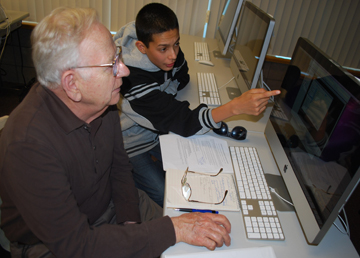
Osher Lifefong Learning at CSU Dominguez Hills offers educational opportunities for retired and semi-retired individuals age 50 and above. Beginning March 22, 2011 the Crenshaw Digital Media Team will teach weekly iPhoto lessons in the brand new OLLI Osher Mac Lab. The team will definitely have more respect for teachers after this. Each student will receive a college letter of reference from Jim Bouchard, Sr. Program Development Specialist & OLLIE Coordinator.
iLife is Apple’s digital media software that comes loaded on all Mac computers. It includes iPhoto, iMovie and Garageband. The students in the Crenshaw Digital Media Team earn their certification in iLife programs and other digital media skills, such as Final Cut Pro video editing software, giving them a competitive edge for working in the digital media sphere.
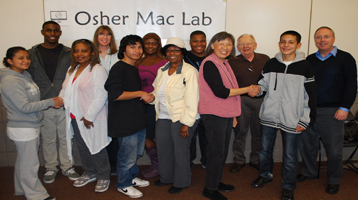
The Food Truck of Ramona Gardens
Jeanette Castro is going to graduate college this spring. Most people from Ramona Gardens don’t.
“They usually end up in jail or, I don’t know, something bad,” said Castro. “It sucks.”
Ramona Gardens is one of the poorest neighborhoods in Los Angeles. The median family income is less than half that of the national average, and 37 percent of the residents live below the poverty line. There are no restaurants, no farmers markets and no community gardens. The nearest grocery store is a 20-minute drive away, an insurmountable distance to many of the residents who don’t have access to a car. Ramona Gardens is a food desert.
If residents can’t find a way to get to the supermarket, their options are limited. The only store is Nico’s Market, a corner convenience store that provides a limited selection of produce, meat and packaged goods. But everything costs more than it would at a grocery store, and the food is often past its expiration date.
“It’s expensive and it’s not worth it,” said Castro. She stood in front of the produce cooler at Nico’s. The cooler has about a dozen different fruits and vegetables and is only partial stocked. “It’s empty. Like, sometimes if you want to buy tomatoes, they’re no tomatoes. Because they’re all with holes or practically black. So you have no options really.”
Ramona Gardens sits just north of the 10 freeway and east of downtown. Many of the buildings are empty, paint chipping from years of neglect. Few cars pass. It is common to see parents on bikes with small children gripping their back, standing on pegs jutting out of the back tire. Ninety percent of the residents speak English as a second language, and more than 90 percent are Hispanic.
“It’s dangerous here, there’re many gangs, many people drink and use drugs,” said Castro. Crime levels are high. According to some residents, police didn’t even patrol the area until 10 years ago.
Even though Nico’s is overpriced, there is constantly a long line at the checkout counter.
“Sometimes people don’t have options,” said Nora Maya, Castro’s mother. “They don’t have a car, they have kids.”
Beyond Nico’s there is one other option for food. Everyday, a truck parks down the block. The old, dilapidated pickup has crates of produce and snacks, everything priced considerably less than at Nico’s. A group of men sit throughout the day.
Castro says the food is not only cheaper, it’s also better. For example, the truck sells strawberries for a dollar, while at the store they’re $2.99. “And they’re still good,” said Castro. “It’s not rotten like at the corner store. This isn’t even a store and they’ve got better quality. And that’s why people come to him.”
The truck has parked in the same spot every day for the last 22 years. In that time, Jose Rodriguez, who owns and runs the truck, has developed a relationship with the community. It allows him to offer something else Nico’s doesn’t: credit. 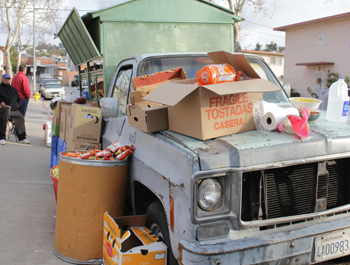
Rodriguez sells food to people, regardless if they have money with them. He keeps his records in a black and white notebook, which is falling apart at the seams. Every page is dedicated to a different family, with long columns that show amounts borrowed and repaid.
“When you need to go to the store, it’s a struggle of money,” said Castro. “Here, you can get what you need without the money, which is a good thing, and pay him later.”
There is no specific credit limit, but people don’t need to settle their accounts in order to get more food. Some pages show a balance that steadily climbs up, owing the truck more and more, but Rodriguez doesn’t cut them off.
“If we can help someone and still run our business, we will,” said Rodriguez.
Rodriguez and his son get their produce every morning from the LA Market Warehouse downtown. He says he is able to charge so little because he doesn’t need to pay for rent, only a vending permit. In a survey conducted by the city about mobile vendors, Rodriguez says his truck was rated the cheapest and he got the highest grade in quality.
In 22 years of operation, Rodriguez says there hasn’t been another option for people to buy food. Long ago, there was a second market next to Nico’s, but Nico’s put them out of business by charging less. When the second market went under, Nico’s prices skyrocketed. “Between over here [at the truck] and over there [at the market], everyone would prefer to go over here,” said Castro.
Related Stories:
Fast food ban changes food landscape in South L.A.
City Councilmembers raise money for victims of Japanese earthquake

Police Commission says officer who shot Guatemalan day laborer followed protocol
Los Angeles Police Chief Charlie Beck sat with the Los Angeles Police Commission as they announced the results of an investigation into the shooting death of Guatemalan day laborer Manuel Jamines. Police Commission President John W. Mack said the three officers acted lawfully when they pulled out their weapons. The investigation also found that Frank Hernandez, the officer who shot and killed Manuel Jamines, followed LAPD protocol when it came to “the categorical use of force.”
Mack read the statement to a packed meeting at the downtown police department. He said the investigation, headed by Inspector General Nicole Bershon, was “comprehensive” and “exhaustive.”
Manuel Jamines, 37, was shot near Sixth Street and Union Avenue in MacArthur Park on September 5th. He was allegedly drunk and waving a knife in the air when three Rampart division police officers on bicycles found him. They issued orders to Jamines in Spanish and English to put the knife down. When Jamines raised the weapon and went toward them, Hernandez fired two rounds.
A day laborer named Tambric (he declined to give his first name) said he roomed with Jamines in an apartment on Wilshire Boulevard and Bonnie Brae Streetfor about four months. Tambric said he is from Nahuala Solola, the same small town in Guatemala where Jamines was from.
“He was a very nice person, but when he was drunk he was a noisy person,” said Tambric, through a translation by Jeronimo Salguero, co-director of the day laborer center CARECEN.
Luis Carrillo, a Pasadena lawyer representing the Jamines family, said he didn’t expect much from the announcement and that he was there “just to hear the script.”
|
Luis Carrillo, Jamines family lawyer, tells reporters the results of the investigation are just a “script.” |
Arcy Carranza, Carrillo’s office administrator, attended the news conference and said she was “very upset and disappointed” with the investigation’s results.
“I wasn’t surprised but upset because I know the family and their feelings,” she said. “I’m frustrated asking, ‘When is this going to end?’”
Some of Jamines’ cousins live in the United States, but could not attend the news conference. Jamines’ wife and three sons still live in Guatemala. Carrillo speaks to the widow through a translator, because the widow only speaks a native dialect. It’s been argued that Jamines didn’t understand the officers’ commands because he too only understood his native language.
The Jamines family is suing Hernandez in federal court, using the official last name Jamines Chun. Carrillo explained that in federal court, he will get what is known as the compel statements from the three officers. Those statements were taken immediately after the shooting and could shed light on what happened. In state court those statements are not released because they are considered “personnel” items. Carrillo doesn’t expect Hernandez will face any jail time, but he is hoping to win a monetary reward to support the family.
After the news conference, Mack said he was confident with the commission’s ruling after verifying the DNA on the knife recovered at the scene matched with Jamines’ DNA. Mack also mentioned that there were several witnesses who verified the officers’ testimonies.
Several witnesses, however, have come forward saying Jamines was not holding a knife in his hand when he was shot.
“I called one [witness] 20 times, and she only answered twice,” said Carrillo. He believes witnesses are scared to come forward and say what they saw. Carrillo is still waiting for the coroner’s report but said the case will ultimately be “a battle between witnesses.”
When asked whether he believed the knife was planted, he shrugged his shoulders and said, “I don’t know.”
Mack mentioned that the commission is “deeply committed to openness of the investigative process with the community,” but that they couldn’t legally say more because “this is a personnel matter.”
Police were expecting protests in MacArthur Park similar to those that happened in the month after the initial shooting.
The complete investigation will be made public and published on the LAPD’s website no later than March 21, 2011.
Race for Los Angeles County DA getting crowded
The election for Los Angeles County District Attorney is still more than a year away, but the race is already starting to shape up. Many people — including current D.A. Steve Cooley himself — may have expected Cooley to be sitting in the California Attorney General’s office by now, but he lost to San Francisco District Attorney Kamala Harris in the November 2010 election. Cooley has not yet said whether he will run for a fourth term as D.A., only that he would consider seeking reelection if no qualified candidates come forward.
As of March 14, there are five candidates who have officially tossed their hats into the ring. It is believed that L.A. City Attorney Carmen Trutanich will run, but he hasn’t officially declared. All of the declared candidates so far are from the D.A.’s office.
Bobby Grace
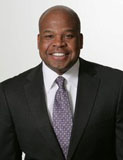 Prosecutor Bobby Grace is the latest candidate to enter the race. He has been in the DA’s office since he graduated from Loyola Law School 23 years ago He is now a prosecutor in the Major Crimes Division. Grace says he has prosecuted more than 60 murder cases. In 1996, while he was in the Hardcore Gang Division, he prosecuted Calvin Broadus (aka Snoop Doggy Dogg) and his bodyguard for murder. In 2002, The Association of Deputy District Attorneys awarded Grace the “Pursuit of Justice Award” for convicting Los Angeles minister Henry Hayes, who was accused of murdering his wife and young daughter.
Prosecutor Bobby Grace is the latest candidate to enter the race. He has been in the DA’s office since he graduated from Loyola Law School 23 years ago He is now a prosecutor in the Major Crimes Division. Grace says he has prosecuted more than 60 murder cases. In 1996, while he was in the Hardcore Gang Division, he prosecuted Calvin Broadus (aka Snoop Doggy Dogg) and his bodyguard for murder. In 2002, The Association of Deputy District Attorneys awarded Grace the “Pursuit of Justice Award” for convicting Los Angeles minister Henry Hayes, who was accused of murdering his wife and young daughter.
Alan Jackson
Prosecutor Alan Jackson was the first candidate to declare his candidacy for D.A. He serves as Assistant Head Deputy of the Major Crimes Division.  In his 16 years in the D.A.’s office, Jackson prosecuted music producer Phil Specter on murder charges and the accused murderer of high school student Lily Burk. He was named Prosecutor of the Year in 2009 and 2010. He got off to an early start on major fundraising efforts, collecting almost $114,000 in campaign donations in December. However, he is a Republican running in a solidly Democratic county.
In his 16 years in the D.A.’s office, Jackson prosecuted music producer Phil Specter on murder charges and the accused murderer of high school student Lily Burk. He was named Prosecutor of the Year in 2009 and 2010. He got off to an early start on major fundraising efforts, collecting almost $114,000 in campaign donations in December. However, he is a Republican running in a solidly Democratic county.
Jacquelyn Lacey

Jacquelyn “Jackie” Lacey is the third ranking administrator in the D.A.’s office and thought to be the closest to Cooley. Lacey grew up in the Crenshaw District and attended Dorsey High School, though she now lives in the Northridge area. She has been a prosecutor in the D.A.’s office for 24 years. Her bio says she is spearheading the movement in the D.A.’s office to bring formal leadership training to everyone who supervises prosecutors. If elected, she would be the first African-American and first female D.A. in L.A. County.
Danette Meyers

Deputy District Attorney Danette Meyers has been with the D.A.’s office for 24 years. She has served as a prosecutor in the Career Criminal Unit, the Special Trials Division of the Van Nuys Branch Office and the Crimes Against Peace Officers Unit. Meyers is handling the prosecution of Lindsay Lohan on charges of stealing a necklace. Lohan has claimed that Meyers is “out to get” her. In all, Meyers has prosecuted some 200 jury trials. If elected, she would be the first African-American and first female D.A. in L.A. County.
Update March 8: Former DA Gil Garcetti endorsed Meyers calling her “a leader, a visionary and a person who clearly understands and accepts the responsibilities of being the elected district attorney heading an office of 1,000 prosecutors.”
Mario Trujillo
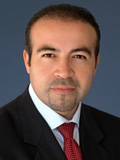
Deputy District Attorney Mario Trujillo is the newest candidate to declare. He made the announcement at the Mexican American Bar Association installation dinner on February 5, where he was honored as Attorney of the Year by the South East District Bar Association. Trujillo lives in Downey; he’s been with the D.A.’s office for 14 years; he now manages the D.A.’s Bellflower Office. He is a former president of the Mexican American Bar Association.
The Los Angeles Dragnet Blog identifies five or six other people who might run, such City Attorney Carmen Trutanich and Former City Attorney Rocky Delgadillo. Check out Los Angeles Dragnet for more extensive discussion on the DA race.
The LA Weekly also has coverage of the candidates.
Pennacle Foundation expands after school community program
The Pennacle Foundation has offered residential services and treatments for youth with mental illnesses or developmental disabilities since 1998. But now, with the founding of a new after-school program at St. Mark’s Lutheran Church in off Vermont Avenue, the program’s leaders hope to expand their offerings to more students in the surrounding community.
Carolyn Ruffin is one of the program’s directors and administrators. She said she’s always seen a need for a special kind of youth center for the kids that Pennacle works with.
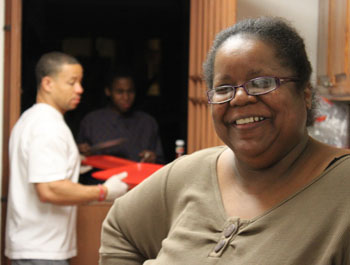
“One of the problems I was finding with the school and with other organizations that provide supportive services to the youth is that our kids are very special when it comes to behaviors and they don’t always fit into that square peg. They’re round,” Ruffin said.
So when St. Mark’s had some space available in the back of its building last summer, Ruffin jumped at the chance to take over the space and launch the youth center.
Three nights a week, around 11 middle and high school students come to St. Mark’s for food, free time, and some kind of special project. This month, they’re breaking into groups and researching different historical figures who have spent time in jail and learning what their lives were like post incarceration.
“They wrote about people from what they’re used to, like Tupac, and also Martin Luther King or someone from history, like Mandela,” said Ruffin.
Once a quarter, academic awards are given out for strong performances at school. Almost everyone gets something, Ruffin said, and those with 3.0 GPAs and above get special certificates printed and displayed on the wall.
In the coming months, the center will add a senior citizens program and set up a community service day on Saturdays. Over the winter holidays, the center was able to hold a holiday party. The students assembled bags of food and were able to offer one to every parent and child that walked through the door.
“Because one of the things I truly believe is that the kids need to learn about empowering their communities and giving back,” Ruffin said. “We want the kids to understand where they’re at, where they came from, and where they’re going.”
Listen to Adrian Nelson, one of the students involved with the Pennacle Foundation, talk about why he loves the after school program at St. Mark’s.















